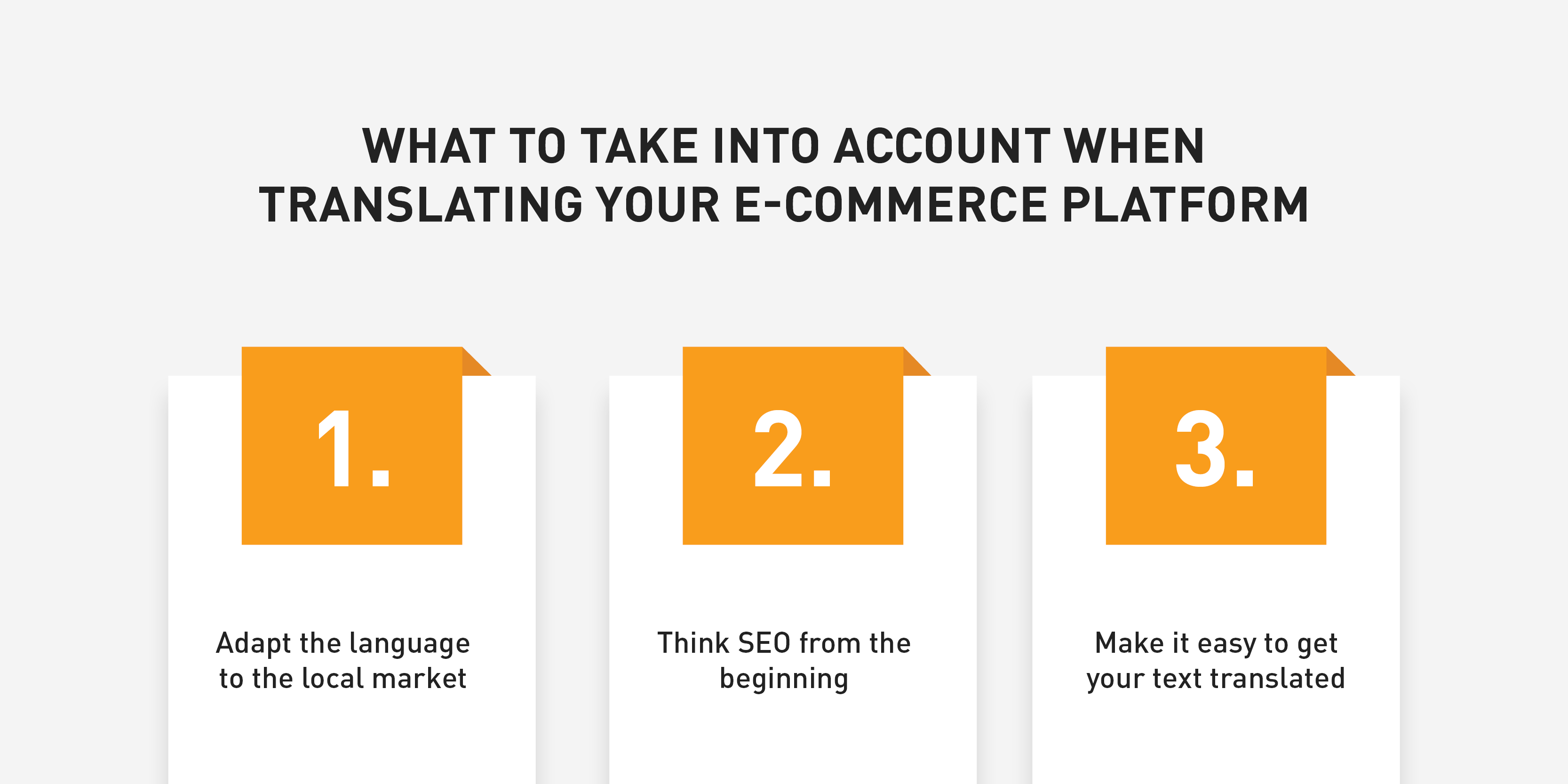BUILD CONSUMER TRUST THROUGH
E-COMMERCE TRANSLATION
When you’re expanding your online shop into new markets, translation isn’t just a checkbox – it’s a trust-building tool. And in 2025, trust is still the thing that turns browsers into buyers.
So if you’re a marketing manager, product owner, or localisation lead juggling multiple languages, tight timelines, and a platform that wasn’t built for multilingual anything – we see you. And we’re here to help.
Here’s what actually matters when it comes to e-commerce translation, and how to do it in a way that builds credibility, scales with your business, and gives your customers a reason to stick around.
Why e-commerce translation matters more than ever
Let’s start with the obvious: if your site isn’t in the customer’s language, most of them won’t buy.
According to CSA Research, 76% of consumers prefer to shop in their native language, and 40% won’t buy from an online shop in another language at all. So if you’re only translating into English and calling it a day, you’re likely leaving revenue on the table.
But it’s not just about language; it’s about confidence. If the translation is clunky, inconsistent, or clearly machine-generated, that confidence disappears. Which leads us to the next point.
Machine translation for e-commerce translation: HELPFUL OR HARMFUL?
There’s nothing wrong with using machine translation (MT) tools if you know what they’re good at. They can be great for internal content or low-risk product updates. But if you rely on them for customer-facing content without human revision, you’re gambling with your brand’s credibility.
No customer trusts an e-commerce site that reads like a bad Google Translate job.
Speed and scalability are important – but not at the expense of trust. A thoughtful approach blends machine translation (MT) and large language model (LLM) tools with human expertise and QA. That way, you get the efficiency you need, without compromising the customer experience.
What does quality e-commerce translation actually involve?
It’s not just about hiring a translator and hoping for the best. If you want a multilingual online shop that builds trust and converts, here’s what you need:
1. Solid source content
Bad input = bad output. If your English copy is unclear, outdated, or riddled with inconsistencies, your translations will suffer.
We recommend running source content through a quick language QA or letting our in-house reviewers polish it before translation begins. A small upfront investment saves a lot of headaches down the line.
2. The right linguists for the job
Marketing copy isn’t the same as legal disclaimers or technical labels. You need domain-specific translators who know when to transcreate, when to stay literal, and how your end users think.
Different types of content call for different types of expertise. Translators familiar with regulatory language will approach a MedTech manual differently from someone working on fashion product descriptions. Having access to subject-matter specialists ensures the right tone, terminology, and treatment for each content type.
3. Localisation that goes beyond language
Translation is part of the puzzle. Localisation is the full picture.
That means adapting:
- currencies
- units of measurement
- date formats
- payment methods
- visuals
- even product names!
It also means making deliberate UX localisation choices. For example, while many Western markets lean toward minimalist interfaces, some Asian markets (like Japan and China) often prefer information-dense layouts that feel ‘complete’ rather than sparse. The structure, flow, and design of your e-commerce site may need to be tailored just as much as the text.
Visuals and layout can shape how users perceive your online shop. Elements like colour schemes, imagery, and navigation patterns might need adjustment to reflect local preferences – what feels clean and intuitive in one region may feel sparse or unfamiliar in another.
4. Translate the entire customer journey
Translating only product pages is like translating half a sentence. Your customer journey likely includes confirmation emails, help centre articles, return policies, and loyalty emails. These matter, too.
A fully localised experience builds trust from first click to final checkout – and back again.
5. Provide for multilingual customer support
Clear post-sales support can make or break international retention. That means localising FAQs, automated replies, live chat scripts, and support articles so customers can find help in their language without jumping through hoops.
6. Legal and compliance translation
Don’t overlook legal. Depending on the market, you may need to translate terms and conditions, privacy policies, or safety disclaimers. We’ll help you comply with local regulations and avoid risk.
7. A proper brief
You’d be surprised how many companies skip this part. A clear brief means better output, faster turnarounds, and fewer rounds of feedback.
Tell your provider who the content is for, your tone of voice, preferred terminology, and what platforms you’re using. If you’re not sure how to brief effectively, use our briefing checklist template.
8. SEO: if they can’t find it, they won’t buy it
Translating your product pages isn’t enough. If you want traffic, your multilingual content needs to be optimised for local search.
That means:
- Doing keyword research for each market
- Adapting metadata and URLs
- Localising product tags and descriptions
Multilingual SEO doesn’t have to be a separate project. It can be built into your translation process – from keyword research to on-page optimisation – so your content has a better chance of showing up in local search results.

Can you have high quality and low prices?
With the right tech, yes. Tight budgets are a reality – especially when scaling across multiple markets. The key is to work smarter, not cheaper.
Translation memory, termbases, and automated QA tools help reduce repetitive work and improve consistency. Instead of redoing the same translations for similar content, these tools reuse what’s already been approved, helping you save time and money without compromising quality.
Tracking how your translated content performs can also guide smarter decisions. If certain phrasing or formats work better in one region, that insight can shape how you approach other markets – making your content more effective over time.
The less manual repetition, the more time your team has to focus on strategy instead of file wrangling.
If your team is manually uploading files every time you update your e-commerce site, you’re doing it the hard way.
introducing smartconnect
To make it as easy, flexible and quick for your to have your texts translated while ensuring good quality and quick time-to-market, you should consider whether you want an integration between your e-commerce platform and your translation provider’s translation platform.
This will make it easy to manage large volumes of text into many languages. AdHoc Translations offers a solution called SmartConnect where you can order translation of your texts with a single click of the mouse and just as easily integrate and publish them on your site.
Universal Robots is one of many customers that we have helped with an efficient integration between their CMS system and our translation platform. Read the case here.
Training and support for your internal team
Rolling out e-commerce translation across teams can be overwhelming – especially when localisation isn’t part of your day-to-day. Internal alignment goes a long way.
Making sure content teams, product owners, legal reviewers, and support teams understand the process and their role in it helps avoid delays and confusion. That might mean creating simple workflows, onboarding reviewers, or just making space for shared terminology and feedback.
It doesn’t need to be perfect – it just needs to be consistent and understood.
E-commerce translation in practice: how we do it at AdHoc
All the recommendations above – from writing a good brief to building translation memory and integrating with your CMS – are baked into how we run e-commerce localisation projects at AdHoc.
Our central hub for making it all work? SmartDesk®.
SmartDesk® is our custom-built platform for managing multilingual content at scale. It’s where teams can:
- Upload and assign content across product, legal, and marketing workflows
- Track progress in real time, with visibility on deadlines and budgets
- Approve translations, leave feedback, and access previous work
- Manage translation memory and termbases to improve consistency
- Connect directly to e-commerce platforms or content systems via API
It’s designed for localisation at speed, without losing control. That means less back-and-forth, fewer manual steps, and better coordination across your internal teams and ours.
Whether you’re translating 100 product descriptions a week or planning a full site rollout across dozens of languages, SmartDesk® gives you the infrastructure to do it smoothly.
And because every client setup is slightly different, we tailor the workflow to your tools, team, and goals. Pharma, MedTech, fashion, manufacturing – the core needs are often the same: control, visibility, and the ability to scale. That’s what we deliver.







